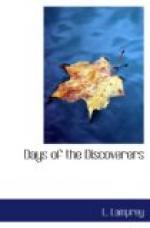[3] The question of the actual whereabouts of Leif Ericsson’s booths and Thorfin Karlsefne’s later settlement has never been positively decided. The Knutson expedition to Greenland is an historical fact. It left Norway about 1354 and returned about 1364. It is not positively known that Knutson attempted the rediscovery of Vinland, unless what is known as the Kensington Rune Stone is evidence of it. The writer has adopted the theory that he did take a party southward, landing at Halifax, and left a part of his men there, intending to return with more colonists; that on returning to Norway he found the country in the throes of war and abandoned any thought of further settlement, leaving his men to find their way back as they could.
[4] The Indian phrases and legends referred to as learned by the Wind-wife are Abenaki.
[5] According to historians the region along the St. Lawrence and the Great Lakes was for a long time inhabited by tribes belonging to the great Ojibway nation. Their territory extended nearly to the western boundary of what is now Minnesota. Southward were the tribes later known as Iroquois.
[6] Accounts of the open galleys of the Northmen agree in describing them as small and light compared with the later decked ships. The open “sea-serpent” of forty-two feet, with her mast unshipped was heavier but not much bigger than the largest Indian carrying-canoes such as were used in the fur-trade, and these were taken from the St. Lawrence through the Great Lakes. Vikings landing in Europe were prepared not only to return by a new route but even to take their boats apart or build new ones if necessary.
[7] Bayard Taylor, visiting the Saguenay and the St. Lawrence immediately after a sojourn in Norway, speaks of his inability to be impressed as others had been, by the height of the cliffs and waterfalls of Canada, although fully appreciating the beauty of the scenery.
[Footnote 8: The Sioux or Dakotas, who occupied the Great Plains, were hereditary enemies of the Ojibways. In the Ojibway language one name for these Plains Indians indicated that they were in the habit of mutilating their victims.]
[9] The monument known as the Kensington Rune Stone was found near Kensington, Minnesota, and is fully described in the reports of the Minnesota Historical Society. It was the subject of many arguments at first. Well known authorities pronounced it a forgery, while other well known authorities declared it genuine. It was pointed out that the language used was not that of the time of Leif Ericsson, but much more modern; but later it was found that the inscription was exactly such as would have been written about the middle of the fourteenth century, when Knutson’s expedition was in Greenland. Aside from the obvious lack of motive for a forgery, investigation showed that neither the farmer nor any one who might have been in a position to bury the stone where it was found had any knowledge of Runic writing. Moreover, if the stone had been a forgery it would seem that the forger would have used the name of some well known leader, whereas no name is mentioned. If Knutson had been with the expedition he would certainly have seen to it that his presence was recorded.




